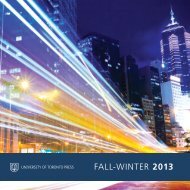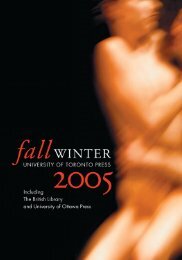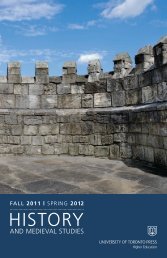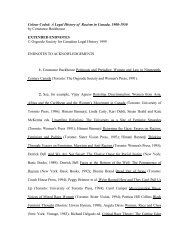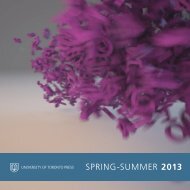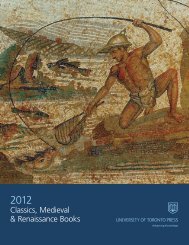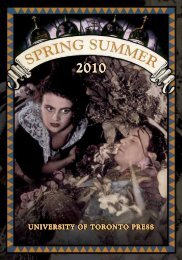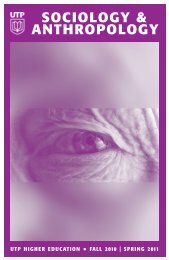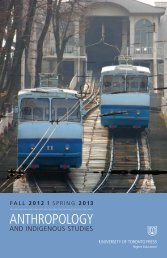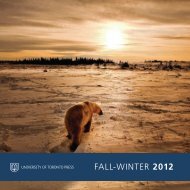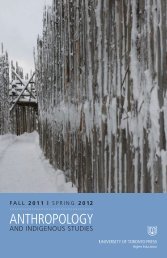Fall/Winter 2006 - University of Toronto Press Publishing
Fall/Winter 2006 - University of Toronto Press Publishing
Fall/Winter 2006 - University of Toronto Press Publishing
You also want an ePaper? Increase the reach of your titles
YUMPU automatically turns print PDFs into web optimized ePapers that Google loves.
C L A S S I C S<br />
Virginity Revisited<br />
Configurations <strong>of</strong> the Unpossessed Body<br />
Edited by Bonnie MacLachlan and Judith Fletcher<br />
STUDIES IN GENDER, PHOENIX SUPPLEMENTARY VOLUMES<br />
From Classical Antiquity to the present, virginity<br />
has been closely allied with power: as someone who<br />
chooses a life <strong>of</strong> celibacy retains mastery over his<br />
or her body. Sexual potency withheld becomes an<br />
energy-reservoir that can ensure independence and<br />
enhance self-esteem, but it can also be harnessed by<br />
public institutions and redirected for the common<br />
good. This was the founding principle <strong>of</strong> the Vestal<br />
Virgins <strong>of</strong> Rome and later in the monastic orders<br />
<strong>of</strong> the middle ages. Mythical accounts <strong>of</strong> goddesses<br />
and heroines who possessed the ability to recover<br />
their virginity after sexual experience demonstrate a<br />
belief that virginity is paradoxically connected both<br />
with social autonomy and the ability to serve the<br />
human community.<br />
Virginity Revisited is a collection <strong>of</strong> essays that<br />
examines virginity not as a physical reality but as a<br />
cultural artefact. By situating the topic <strong>of</strong> virginity<br />
within a range <strong>of</strong> historical ‘moments’ and using a<br />
variety <strong>of</strong> methodologies, Virginity Revisited illuminates<br />
how chastity provided a certain agency,<br />
autonomy, and power to women. This is a study <strong>of</strong><br />
the positive and negative features <strong>of</strong> sexual renunciation,<br />
from ancient Greek divinities and mythical<br />
women, in Rome’s Vestal Virgins, in the Christian<br />
martyrs and Mariology in the Medieval and early<br />
Modern period, and in Grace Marks, the heroine<br />
<strong>of</strong> Margaret Atwood’s novel Alias Grace.<br />
Bonnie MacLachlan is a pr<strong>of</strong>essor in the Department<br />
<strong>of</strong> Classics at the <strong>University</strong> <strong>of</strong> Western Ontario.<br />
Judith Fletcher is an associate pr<strong>of</strong>essor in the<br />
Department <strong>of</strong> Classics at Wilfrid Laurier <strong>University</strong>.<br />
Mortuary Landscapes <strong>of</strong><br />
North Africa<br />
Edited by David L. Stone and Lea M. Stirling<br />
PHOENIX SUPPLEMENTARY VOLUMES<br />
Cemetery and landscape studies have been hallmarks<br />
<strong>of</strong> North African archaeology for more than one<br />
hundred years. Mortuary Landscapes <strong>of</strong> North Africa<br />
is the first book to combine these two fields by considering<br />
North African cemeteries within the context<br />
<strong>of</strong> their wider landscapes. This unique perspective<br />
allows for new interpretations <strong>of</strong> notions <strong>of</strong> identity,<br />
community, imperial influence, and sacred space.<br />
Based on a wealth <strong>of</strong> material research from current<br />
fieldwork, this collection <strong>of</strong> essays investigates<br />
how North African funerary monuments acted as<br />
regional boundaries, markers <strong>of</strong> identity and status,<br />
and barometers <strong>of</strong> cultural change. The essays cover<br />
a broad range in terms <strong>of</strong> space and time – from<br />
southern Libya to eastern Algeria, and from the<br />
seventh century BCE to the seventh century CE. A<br />
comprehensive introduction explains the importance<br />
<strong>of</strong> the ‘landscape perspective’ that these studies bring<br />
to North African funerary monuments, while individual<br />
case-studies address such topics as the African<br />
way <strong>of</strong> death among the Garamantes, the ritual<br />
reasons for the location <strong>of</strong> certain Early Christian<br />
tombs, Punic burials, Roman cupula tombs, and the<br />
effects <strong>of</strong> rapid state formation and imperial incorporation<br />
on tomb builders. Unique in both scope<br />
and perspective, this volume will prove invaluable to<br />
a cross-section <strong>of</strong> archaeological scholars.<br />
David L. Stone is an assistant pr<strong>of</strong>essor in the<br />
Department <strong>of</strong> Classics at Florida State <strong>University</strong>.<br />
Lea M. Stirling is an associate pr<strong>of</strong>essor in the<br />
Department <strong>of</strong> Classics at the <strong>University</strong> <strong>of</strong><br />
Manitoba and holds a Canada Research Chair in<br />
Roman Archaeology.<br />
Approx. 220 pp / 6 x 9 / December <strong>2006</strong><br />
Cloth ISBN 0-8020-9013-3 / 978-0-8020-9013-3<br />
£35.00 $55.00 E<br />
Approx. 270 pp / 6 x 9 / November <strong>2006</strong><br />
45 half tones<br />
Cloth ISBN 0-8020-9083-4 / 978-08020-9083-6<br />
£48.00 $75.00 E<br />
39




